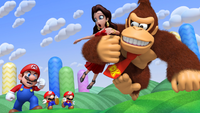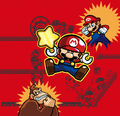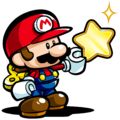Mario vs. Donkey Kong: Tipping Stars
Mario vs. Donkey Kong: Tipping Stars is a game for the Wii U and Nintendo 3DS. As the sixth Mario vs. Donkey Kong game, it is the first Mario vs. Donkey Kong game to also be released on a home console. The game shares many elements with most of the series, and also debuts new features such as sharing custom stages through Miiverse. Parts and new minis can be unlocked in the Workshop Store after paying for them with stars, which can also be given to other players as a "tip" for their shared stages. The game is digital only except in Japan. Game cases with download codes are sold in Europe. The Wii U version requires 0.93 GB of memory to be installed, and the Nintendo 3DS version requires 3200 blocks.[1]
Story
As in previous Mario vs. Donkey Kong games, Pauline is once again the victim of Donkey Kong's kidnapping antics at the start of the game, although this time, no motivation is given. Mario quickly gives chase with his Mini Mario toys in hopes of rescuing Pauline from Donkey Kong.
After traversing six puzzle-filled worlds, while freeing cursed Mini Mario toys along the way, Mario catches up to Donkey Kong and Pauline in a darkened room. The lights are switched on quickly, revealing Pauline, Donkey Kong, and two Toads standing in front of a "SURPRISE!" banner.
The ruse revealed, Mario can then continue through more worlds and bonus levels knowing Pauline is safe.
Gameplay
As in the game's predecessors, the main goal of every stage is to simply lead all Mini toys to the end of the level, which is done by manipulating certain parts of the environment. Using the stylus, players are able to drag objects such as red girders, springs, conveyor belts, pipes, and lifts to guide the characters. Notably, the gameplay of this title is largely simplified in comparison to the predecessors, barring elements such as boss battles and the ability to change direction of the Minis.
The most common level type in the game is the Single-Door level, in which a lone door represents the objective. In order to clear a course, each Mini must be brought at the exit door, immediately followed by another. The first Mini toy to reach the exit commences a short timer which shuts the door after a few moments, locking away any other Mini toy if they do not reach the door in time and resulting in a Game Over. Multi-Door levels, a feature introduced in Mario vs. Donkey Kong: Mini-Land Mayhem!, are also found in Tipping Stars, where different Minis have to be rescued from Capsules and led through separate doors, each assigned to one of the Minis. In Multi-Door levels, there is no time limit between entering different doors.
Each world contains eight levels that are mostly formulaic. Specifically:
- the first level of every world defines the use of a new main mechanic, which becomes recurrent from that point onward.
- the third level is where enemies that cause damage, like Shy Guys, Pokeys or Thwomps, appear.
- the fourth level is always a Multi-Door course, the rest being Single-Door.
- the fifth level is characterized by the presence of a type of Kong toy, such as Circus Kongs, Cannon Kongs or Capture Kongs.
- the seventh level has a locked exit, which can only be opened by a Mini Mario that carries a key.
Instead of a boss battle as in the predecessors, every world is closed by a level where a Cursed Mini Mario has to be reverted to its normal state by hitting it with Hammers, then escorted along with the other Minis to the exit door.
A level must be finished within its time limit, always set to 300 seconds. Otherwise, the result will be a Game Over. Other causes of a Game Over include falling on spikes, falling from a height of ten blocks or more, failing to enter the goal door before it closes, and coming into contact with an enemy such as a Shy Guy or a Pokey.[2] The only possibility to combat these enemies is by using Hammers, which are acquired for a short time and function similarly to the hammer from the Donkey Kong arcade game.
Scoring system
The game presents a scoring system, which factors the following:
- Small and big coins spread throughout the levels. They are worth 100 and 1000 points, respectively. There is also a single M Coin in each level, worth 2000 points. Collecting all coins in a level awards the player an additional 6000 points.
- Every second left on the timer, each worth 20 points.
Three high scores are established for each level and are linked to a bronze, silver, and gold trophy, in order from lowest to highest. Acquiring one trophy rewards the player with one star; in this respect, achieving the gold trophy in a level signifies a three star rating for that level. Stars form a collectable entity, and a total of 267 stars can be earned in the main game.
Workshop and online features
The Workshop mode allows players to build custom levels. They can either start building from scratch, or edit one of the three built-in templates. A total of 50 custom levels can be stored, but only up to 20 could be shared online. Levels can be transferred between both the Nintendo 3DS and the Wii U versions of the game. The Workshop Store is a section in the Workshop where collected/received stars can be used to purchase objects and other elements that can be used to customize the look of created levels.
A help menu is available where players can learn about earning tips from other players, limits of the resource items, play-testing and themes for their custom levels.
The game had online functions, which were paired with Miiverse. However, as of November 7, 2017, when the service was shut down, they are no longer accessible. Before the discontinuation, levels could be shared trough the Community option. Players could share, play, and 'Yeah' levels. Stars earned in the main game or by playing user-created levels could be tipped to level creators, which unlocked Miiverse stamps. Nintendo themselves had uploaded levels in the past, a list of which can be seen here.
Lastly, in both the Workshop mode and, previously, Community mode, players can click their Mii icon to access their user profile, which displays some information linked to Miiverse: the number of 'Yeah's received on their levels, comments posted, and stars tipped to other players, as well as the number of shared levels. Likewise, the SpotPass funcionality can be adjusted there.
Characters
- Mario
- Donkey Kong
- Pauline
- Mini Mario
- Mini Toad
- Mini Peach
- Mini Donkey Kong
- Mini Pauline
- Mini Luigi
- Gold Mini Mario
- Cursed Mini Mario
Worlds
Each of the eight main worlds of the game (six standard, two extra) introduces a new mechanic, and is divided into eight levels; the last one in each world is always centered around a Cursed Mini Mario. Levels in the main game are unlocked in a classic manner, i.e. by completing any level that preceded them.
Apart from the main game, there are 24 additional levels to unlock in a separate, Bonus feature. The player unlocks a bonus level for every 4 gold trophies obtained in the main game, except for Level B-21 onward, when levels are unlocked for each gold trophy earned. In order to unlock all Bonus levels, the player has to acquire a total of 87 gold trophies. Compared to levels from the main game, Bonus levels are to be noted for using previous gameplay mechanics in challenging ways, resulting in increased difficulty.
The four unlockable backgrounds in the Workshop—Winding Ravine, Swirling Courtyard, Clattering Cabin and Shimmering Gold Palace—do not have their own worlds, but are used to theme some of the Bonus levels. There is also an Editor Land theme for the Workshop; however, none of the pre-built levels feature it.
Each world including the workshop backgrounds (excluding Editor Land) is the setting of two Bonus levels, except for Winding Ravine and Swirling Courtyard, which have three Bonus levels each.
| Main worlds | |||
|---|---|---|---|
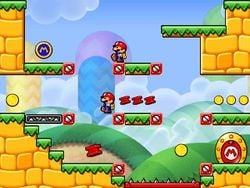
|
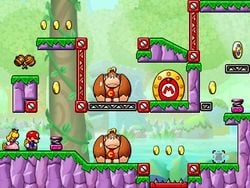
|

|
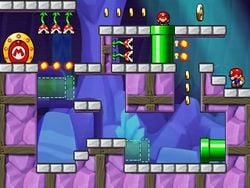
|
| World 1 Rolling Hills Introduces the simple mechanics used throughout the game, such as girders, rivets and ladders. Except for Cursed Mini Mario at the end, only a single Shy Guy is present as an enemy. Levels 1-1 • 1-2 • 1-3 • 1-4 1-5 • 1-6 • 1-7 • 1-8 |
World 2 Jumpy Jungle A world that focuses on the use of Horizontal and Vertical Springs. Circus Kongs are also introduced here. Levels 2-1 • 2-2 • 2-3 • 2-4 2-5 • 2-6 • 2-7 • 2-8 |
World 3 Runaway Warehouse The emphasis of this world are the conveyor belts, many of which are purple and can be stretched between rivets. There are enemies as well, such as Thwomps and Cannon Kongs. Levels 3-1 • 3-2 • 3-3 • 3-4 3-5 • 3-6 • 3-7 • 3-8 |
World 4 Crumbling Cavern A place teeming with Movable Pipes, green pipes which can be positioned conveniently. A few Fire Piranha Plants inhabit this world. Levels 4-1 • 4-2 • 4-3 • 4-4 4-5 • 4-6 • 4-7 • 4-8 |
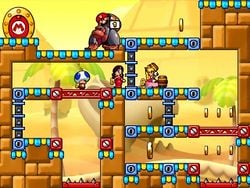
|
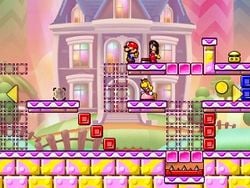
|
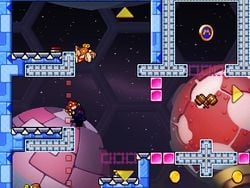
|
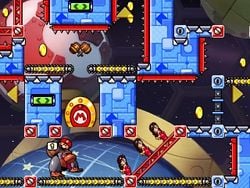
|
| World 5 Dashing Desert This world introduces Blue Lifts and also marks the first appearance of Pokeys and Capture Kongs in the game. Levels 5-1 • 5-2 • 5-3 • 5-4 5-5 • 5-6 • 5-7 • 5-8 |
World 6 Twilight Valley The last world before the game's conclusion. It adds Pink Blocks to the gameplay, which act as solid walls and platforms and can be placed or removed. Levels 6-1 • 6-2 • 6-3 • 6-4 6-5 • 6-6 • 6-7 • 6-8 |
Worlds E1 and E2 Orbiting Observatory Two extra worlds in the main game, in which magnet surfaces are first explored. Many other elements introduced in previous worlds appear. Levels E1-1 • E1-2 • E1-3 • E1-4 • E1-5 • E1-6 • E1-7 • E1-8 E2-1 • E2-2 • E2-3 • E2-4 • E2-5 • E2-6 • E2-7 • E2-8 | |
| Bonus worlds | |||
|---|---|---|---|
| Bonus 1 Levels B-1 • B-2 • B-3 • B-4 B-5 • B-6 • B-7 • B-8 |
Bonus 2 Levels B-9 • B-10 • B-11 • B-12 B-13 • B-14 • B-15 • B-16 |
Bonus 3 Levels B-17 • B-18 • B-19 • B-20 B-21 • B-22 • B-23 • B-24 | |
Items and Obstacles
- Blockers
- Blue Lifts
- Blue Lift Pickups
- Cannons
- Coins
- Color Switches
- Conveyors
- Conveyor Pickups
- Crumble Blocks
- Girders
- Girder Pickups
- Mini Doors
- Hammers
- Horizontal Springs
- Ladders
- Magnet Rods
- M-Tokens
- Pink Blocks
- Purple Conveyors
- Spikes
- Vertical Springs
- Violet Springs
- Warp Pipes
- Yellow Springs
Enemies
- Cannon Kongs[3]
- Capture Kongs
- Circus Kongs
- Fire Piranha Plants[4]
- Piranha Plants[4]
- Pokeys
- Shy Guys[4]
- Thwomps[4]
Stamps
- Main article: List of Mario vs. Donkey Kong: Tipping Stars stamps
Like some other Wii U games, this game features stamps. One way of getting those is by buying items in the Workshop Store. 84 stamps can be collected.[5]
Cross-Play promotion
When one version of the game has been bought on the Nintendo eShop, the player will receive a download code for a free download of the other version. Levels are also able to be shared between the 3DS and Wii U versions of the game.
Gallery
- For this subject's image gallery, see Gallery:Mario vs. Donkey Kong: Tipping Stars.
- MVSDK Wii U TIPPING STARS.jpg
The game's official North American logo
Mini Donkey Kong, Mini Mario, Mini Peach, and the newest addition to the toys, Mini Luigi
Media
| It has been suggested that audio and/or video file(s) related to this section be uploaded. Reason: 3DS and Wii U Please upload all related music, sound effects, voice clips, or any videos for this section. See the help page for information on how to get started. |
Staff
Names in other languages
| Language | Name | Meaning |
|---|---|---|
| Japanese | マリオvs.ドンキ—コング みんなでミニランド Mario buiesu Donkī Kongu Minna de Mini Rando |
Mario vs. Donkey Kong: Mini-Land with Everyone |
External links
References
- ^ European box arts
- ^ Mario vs. Donkey Kong: Tipping Stars digital manual
- ^ http://youtu.be/r33Fbn7u9cU?t=1m6s
- ^ a b c d Mario vs Donkey Kong: Tipping Stars - Overview Trailer (Japanese)
- ^ http://www.nintendo.co.jp/wiiu/wafj/play/index.html Nintendo. Retrieved Feb. 27, 2015.
| Mario vs. Donkey Kong: Tipping Stars | ||
|---|---|---|
| Characters | Donkey Kong • Mario • Pauline • Toads | |
| Minis | Cursed Mini Mario • Gold Mini Mario • Mini Donkey Kong • Mini Luigi • Mini Mario • Mini Pauline • Mini Peach • Mini Toad | |
| Enemies | Donkey Kong's robots (Cannon Kong · Capture Kong · Circus Kong) • Fire Piranha Plant • Piranha Plant • Pokey • Shy Guy • Thwomp | |
| Worlds | Rolling Hills • Jumpy Jungle • Runaway Warehouse • Crumbling Cavern • Dashing Desert • Twilight Valley • Orbiting Observatory • Bonus Levels (Bonus 1 · Bonus 2 · Bonus 3) | |
| Objects | Items | Coin (large) • Hammers • M Coin • Pickup |
| Resource items | Blue Lift • Movable Pipe • Pink Block • Purple Conveyor • Red Girder • Spring | |
| Fixed objects | Cannon • Color Switch • Conveyor Belt • Girder • Goal Door • Ladder • Magnet Ground • Rock • Spikes • Warp Pipe | |
| Further info | Gallery • Media • Official online levels • Slide • Staff (Nintendo 3DS version · Wii U version) • Stamps • Workshop Store | |
Template:MarioGames Template:DKGames
